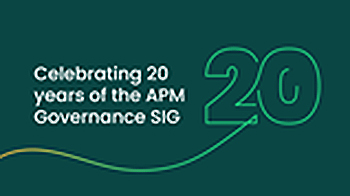20 Years of the APM Governance Specific Interest Group
On Wednesday 29 October 2003 a group of eleven project professionals met in Oxford at the SAID Business School to discuss how OECD’s principles of corporate governance could and should apply to project governance. In 2003 Corporate Governance was a hot topic after the collapse of WorldCom and Enron in the US and the fraud and bankruptcy of the Mirror Group Newspapers earlier in the 90s in the UK. The US and UK took widely different approaches. The UK through its Combined Code for Corporate Governance adopted a ‘comply or explain’ approach and the US through its Sarbanes-Oxley Act put in place a prescriptive mandatory regime.
With corporate governance biased towards ‘business as usual’ operations, the group agreed that the relationship between the temporary project organisation and the permanent corporate organisation(s) that projects belong to needed strengthening. It also needed to address the contrasting approaches depending on the governance code that has jurisdiction of the corporate body. Chaired by David Shannon, those present established what would become APM’s Governance Specific Interest Group (SIG) with the aim to “influence directors and others to adopt excellent practices regarding programmes and significant projects. This involves aligning the interests of directors, of programme and project teams and of wider stakeholders”.
A year later in 2004 the SIG published its first guide, Directing Change, aimed at the Board of Directors or those who report to the Board. The second edition of the guide was developed in collaboration with the Institute of Directors with a joint foreword by their respective leaders – the Director General of the Institute of Directors (IoD) and the APM’s Chair. The co-signatories on the guide reflected the outward looking approach the SIG established with a focus on outreach to non-project folk such as directors, company secretaries, legal counsel and regulators.
The collaboration with the IoD extended beyond the guide and included a joint conference and several joint branch events. The project community learned the principles and history of corporate governance dating back to the first incorporated businesses (17th Century tea clippers) and the directors and business leaders leaned about the need for ‘additional governance arrangements’ to empower project leaders and hold them to account. In 2015 the SIG delved deeper into the past when it held a joint event with the British Library to celebrate the 800 year anniversary of the Magna Carta, exploring how the ‘deal’ to separate power and accountability between the crown, landowners, citizens and those elected to represent them is reflected in modern governance arrangements.
Since Directing Change was first published the SIG has continued to review and update it to reflect the latest developments in both corporate governance and the world of project management. Now in its third edition it is joined by supplementary guidance on the governance of co-owned projects, the governance of agile projects and the role of the sponsor in sponsoring change.
As Chair, David Shannon passed the baton to Martin Samphire who likewise passed it to Andy Murray. With an outreach focus the three Chairs have been supported by a committed group of volunteers to achieve the influence it set out at the inaugural meeting. Several of those who attended that meeting continued to be involved with the SIG until only recently and all three Chairs past and present thank them for their great contribution. The influence from the Governance SIG guides is evident in how they have been cited by the BSI, National Audit Office, the Infrastructure & Projects Authority, HM Treasury and numerous project organisations such as Network Rail Transport for London in their reports, standards and guides.
The aim of Governance SIG has not fundamentally changed since that inaugural meeting and the publication of its first guide. The SIG and its publications continue to focus on the interface between the world of projects and the world of corporate governance. The next chapter of the SIG (as the APM transitions to communities of interest) is likely to be an exciting and important one as governance is increasingly in the spotlight whether to improve how projects align to their organisation’s ESG priorities and commitments (e.g. Net Zero or nature net gain), safeguarding stakeholder or shareholder interests, addressing the pace of disruptive change (e.g. Generative AI) or to improve public confidence in the value we gain from projects. As we know….. when projects succeed, society succeeds.
This article appears on the APM news and blog site as "Celebrating 20 Years of the APM’s Governance Specific Interest Group" dated October 29, 2023.
--Association for Project Management
[edit] Related articles on Designing Buildings
- Association for Project Management articles
- Draft environment (principles and governance) bill.
- GDPR.
- Governance.
- Governance for Railway Investment Projects (GRIP).
- Governance risks.
- Governance statement.
- Government Construction Strategy.
- Procurement.
- Public procurement.
- Public project.
- Risk.
- Risk management.
- The construction playbook.
- The green book.
- Types of risk.
Featured articles and news
UK Infrastructure: A 10 Year Strategy. In brief with reactions
With the National Infrastructure and Service Transformation Authority (NISTA).
Ebenezer Howard: inventor of the garden city. Book review.
The Grenfell Tower fire, eight years on
A time to pause and reflect as Dubai tower block fire reported just before anniversary.
Airtightness Topic Guide BSRIA TG 27/2025
Explaining the basics of airtightness, what it is, why it's important, when it's required and how it's carried out.
Construction contract awards hit lowest point of 2025
Plummeting for second consecutive month, intensifying concerns for housing and infrastructure goals.
Understanding Mental Health in the Built Environment 2025
Examining the state of mental health in construction, shedding light on levels of stress, anxiety and depression.
The benefits of engaging with insulation manufacturers
When considering ground floor constructions.
Lighting Industry endorses Blueprint for Electrification
The Lighting Industry Association fully supports the ECA Blueprint as a timely, urgent call to action.
BSRIA Sentinel Clerk of Works Training Case Study
Strengthening expertise to enhance service delivery with integrated cutting-edge industry knowledge.
Impact report from the Supply Chain Sustainability School
Free sustainability skills, training and support delivered to thousands of UK companies to help cut carbon.
The Building Safety Forum at the Installershow 2025
With speakers confirmed for 24 June as part of Building Safety Week.
The UK’s largest air pollution campaign.
Future Homes Standard, now includes solar, but what else?
Will the new standard, due to in the Autumn, go far enough in terms of performance ?
BSRIA Briefing: Cleaner Air, Better tomorrow
A look back at issues relating to inside and outside air quality, discussed during the BSRIA briefing in 2023.
Restoring Abbotsford's hothouse
Bringing the writer Walter Scott's garden to life.
Reflections on the spending review with CIAT.
Retired firefighter cycles world to raise Grenfell funds
Leaving on 14 June 2025 Stephen will raise money for youth and schools through the Grenfell Foundation.
Key points for construction at a glance with industry reactions.

























